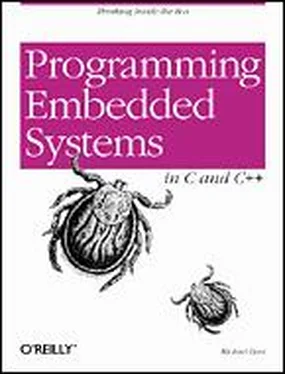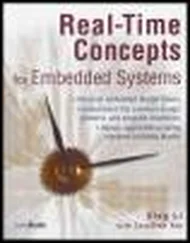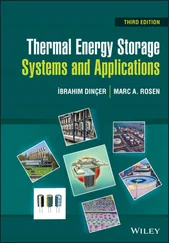Flash memory
A RAM-ROM hybrid that can be erased and rewritten under software control. Such devices are divided into blocks, called sectors, that are individually erasable. Flash memory is common in systems that require nonvolatile data storage at very low cost. In some cases, a large Flash memory is even used instead of a disk-drive.
general-purpose computer
A combination of computer hardware and software that serves as a general-purpose computing platform. For example, a personal computer. Contrast with embedded system .
HLL
See high-level language.
heap
An area of memory that is used for dynamic memory allocation. Calls to malloc and free and the C++ operators new and delete result in runtime manipulation of the heap.
high-level language
A language, such as C or C++, that is processor-independent . When you program in a high-level language, it is possible to concentrate on algorithms and applications without worrying about the details of a particular processor .
host
A general-purpose computer that communicates with the target via a serial port or network connection. This term is usually used to distinguish the computer on which the debugger is running from the embedded system that is being developed.
ICE
In-Circuit Emulator. See emulator.
I/O
Input/Output. The interface between a processor and the world around it. The simplest examples are switches (inputs) and LEDs (outputs).
I/O device
A piece of hardware that interfaces between the processor and the outside world. Common examples are switches and LEDs, serial ports, and network controllers.
I/O map
A table or diagram containing the name and address range of each peripheral addressable by the processor within the I/O space . I/O maps are a helpful aid in getting to know the hardware.
I/O space
A special memory region provided by some processors and generally reserved for the attachment of I/O devices . Memory locations and registers within an I/O space can be accessed only via special instructions. For example, processors in the 80x86 family have special I/O space instructions called in and out . Contrast with memory space .
ISR
See interrupt service routine.
instruction pointer
A register in the processor that contains the address of the next instruction to be executed. Also known as a program counter .
interrupt
An asynchronous electrical signal from a peripheral to the processor . When the peripheral asserts this signal, we say that an interrupt occurs. When an interrupt occurs, the current state of the processor is saved and an interrupt service routine is executed. When the interrupt service routine exits, control of the processor is returned to whatever part of the software was previously running.
interrupt latency
The amount of time between the assertion of an interrupt and the start of the associated interrupt service routine .
interrupt service routine
A piece of software executed in response to a particular interrupt .
interrupt type
A unique number associated with each interrupt .
interrupt vector
The address of an interrupt service routine .
interrupt vector table
A table containing interrupt vectors and indexed by interrupt type . This table contains the processor's mapping between interrupts and interrupt service routines and must be initialized by the programmer.
intertask communication
A mechanism used by tasks and interrupt service routines to share information and synchronize their access to shared resources. The most common building blocks of intertask communication are semaphores and mutexes .
linker
A software development tool that accepts one or more object files as input and outputs a relocatable program. The linker is thus run after all of the source files have been compiled or assembled.
locator
A software development tool that assigns physical addresses to the relocatable program produced by the linker . This is the last step in the preparation of software for execution by an embedded system , and the resulting file is called an executable . In some cases, the locator's function is hidden within the linker .
logic analyzer
A hardware debugging tool that can be used to capture the logic levels (0 or 1) of dozens, or even hundreds, of electrical signals in real time. Logic analyzers can be quite helpful for debugging hardware problems and complex processor-peripheral interactions.
memory map
A table or diagram containing the name and address range of each peripheral addressable by the processor within the memory space . Memory maps are a helpful aid in getting to know the hardware.
memory-mapped I/O
Common hardware design methodology in which I/O devices are placed into the memory space rather than the I/O space . From the processor's point of view, memory-mapped I/O devices look very much like memory devices.
memory space
A processor's standard address space. Contrast with I/O space .
microcontroller
A microcontroller is very similar to a microprocessor . The main difference is that a microcontroller is designed specifically for use in embedded systems . Microcontrollers typically include a CPU , memory (a small amount of RAM , ROM , or both), and other peripherals on the same chip. Common examples are the 8051, Intel's 80196, and Motorola's 68HCxx series.
microprocessor
A piece of silicon containing a general-purpose CPU . The most common examples are Intel's 80x86 and Motorola's 680x0 families.
monitor
In the context of this book, a debug monitor . However, there is a second meaning for this word that is associated with intertask communication . In that context, a monitor is a language-level synchronization feature.
multiprocessing
The use of more than one processor in a single computer system. So-called "multiprocessor systems" usually have a common memory space through which the processors can communicate and share data. In addition, some multiprocessor systems support parallel processing .
multitasking
The execution of multiple software routines in pseudoparallel. Each routine represents a separate "thread of execution" and is referred to as a task. The operating system is responsible for simulating parallelism by parceling out the processor's time.
mutex
A data structure for mutual exclusion , also known as a binary semaphore . A mutex is basically a multitasking –aware binary flag that can be used to protect critical sections from interruption.
Читать дальше












